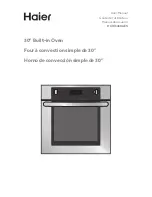
COOKING FRESH VEGETABLES
COOKING MEAT, FISH & POULTRY
DEFROSTING & COOKING
178
●
When buying food items, tr y to ensure that, as
far as possible, they are of similar size. This will
ensure that they are cooked properly.
●
Before preparation wash meat, fish and poultr y
thoroughly under cold running water and pat
them dry with kitchen paper . Then continue as
normal.
●
Beef should be well hung and have little gristle.
●
Even though the pieces may be of a similar size,
cooking results may var y. This is due, amongst
other things, to the kind of food, variations in
the fat and moisture content as well as the
temperature before cooking.
●
Turn large pieces of meat, fish or poultr y half
way through the cooking time, so that they are
cooked evenly from all sides.
●
After cooking cover roasts with aluminium foil
and allow them to stand for approx. 10 minutes
(standing time). During this period the roast
carries on cooking and the liquid is evenly
distributed, so that when it is car ved a minimum
amount of juice is lost.
●
When buying vegetables tr y to ensure that, as
far as possible, they are of similar size. This is
particularly important when you want to cook
the vegetables whole (e.g. boiled potatoes).
●
Wash the vegetables before preparing them,
clean them and only then weigh the required
quantity for the recipe and chop them up.
●
Season them as you would nor mally, but as a
rule only add salt after cooking.
●
Add about 5 tbsps of water for 500 g of
vegetables. Vegetables which are high in fibre
require a little more water . You will find
information about this in the table (see page
191).
●
Vegetables are usually cooked in a dish with a
lid. Those with a high moisture content, e.g.
onions or boiled potatoes, can be cooked in
microwave cling film without adding water.
●
After half the cooking time has elapsed
vegetables should be stirred or turned over.
●
After cooking allow the vegetables to stand for
approx. 2 minutes, so that the temperature
disperses evenly (standing time).
●
The cooking times given are guidelines and
depend upon the weight, initial temperature and
condition of the type of vegetable in question.
The fresher the vegetables, the shor ter the
cooking times.
Deep-frozen dishes can be thawed and cooked at
the same time in one process in your microwave.
You will find some examples in the table (see page
192). Do take note, however , of the general
advice given on "heating" and "thawing" food.
Please refer to the manufacturer's instructions on
the packaging when preparing deep- frozen
dishes. These usually contain precise cooking times
and offer advice on preparation.
















































